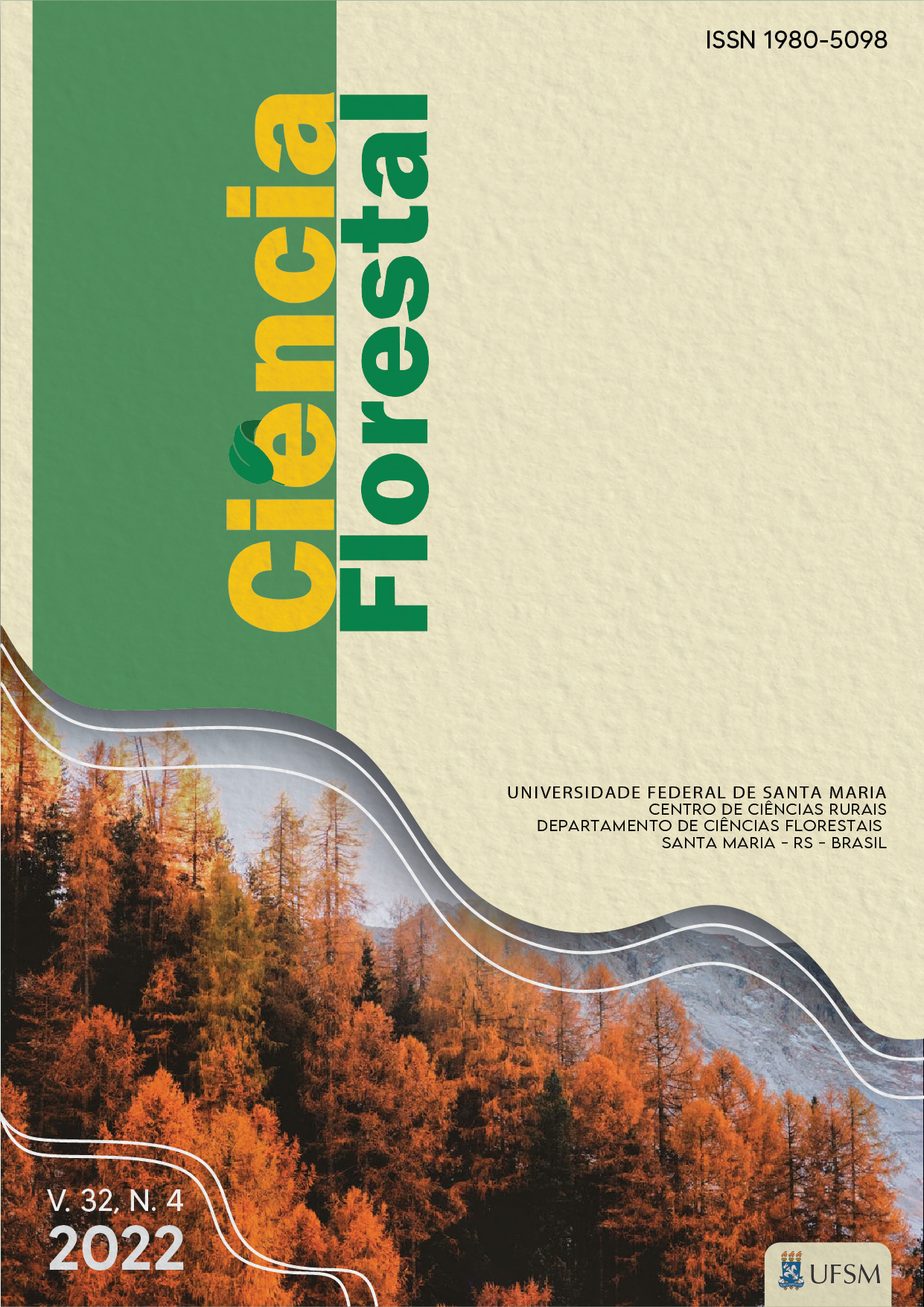Estoque de nutrientes e decomposição da serapilheira em sistemas agroflorestais no município de Belterra – Pará
DOI:
https://doi.org/10.5902/1980509846854Palavras-chave:
necromassa, ciclagem de nutrientes, coeficiente de decomposiçãoResumo
O estudo sobre a ciclagem de nutrientes da serapilheira em sistemas agroflorestais permite avaliar possíveis alterações de técnicas de manejo e possibilita inferir a sustentabilidade desses plantios. Este estudo teve como objetivo avaliar a taxa de decomposição e liberação de nutrientes em diferentes sistemas agroflorestais no município de Belterra, Pará. A coleta da serapilheira produzida foi realizada mensalmente durante um ano, no intervalo de setembro de 2015 a agosto de 2016, a partir de seis coletores dispostos aleatoriamente em cada área. Para determinação do estoque de serapilheira, foram feitas três coletas, compreendendo o início do período seco (agosto de 2015), início do período chuvoso (janeiro de 2016) e no final do período chuvoso (junho de 2016), através de seis amostragens por área. Em laboratório, o material foi triado nas frações folha, material lenhoso, estrutura reprodutiva e material fragmentado, e posteriormente seco em estufa a 70ºC. A decomposição e a liberação de macronutrientes foram avaliadas considerando o peso da massa seca através das equações de Olson (1963). Em média as maiores taxas de liberação dos macronutrientes N, P e K ocorreram no SAF 3, que possui em seu arranjo a espécie Moringa oleifera Lam, assim como a maior taxa de decomposição (K) e o menor período de renovação (1/k). O maior estoque de macronutrientes foi verificado no SAF 2, assim como a menor taxa de decomposição, devido ao maior acúmulo de fração foliar, arranjo adensado e a presença de uma espécie caducifólia (Spondias mombin L.) como componente do sistema.
Downloads
Referências
ALVARES, C. A. et al. Koppen’s climate classification map for Brazil. Meterologische Zeitschrift, v. 22, n. 6, p. 711-728, dez. 2013.
ANDRADE, R. P. A. et al. Aplicação de calcário calcítico em função de diferentes relações Ca: Mg no desenvolvimento inicial da cultura do milho. Almanaque Ciências Agrárias, v. 1, n. 1, p. 20-28, nov. 2019.
ASHFORD, O. S. et al. Litter manipulation and the soil arthropod community in a lowland tropical rain forest. Soil Biology & Biochemistry, v. 62, p. 5 - 12, jul. 2013.
BARBOSA, V. et al. Biomassa, Carbono e Nitrogênio na Serapilheira Acumulada de Florestas Plantadas e Nativa. Floresta e Ambiente, v. 24, e20150243, abr. 2017.
CALDEIRA, M. V. W. et al. O. Biomassa e nutrientes da serapilheira em diferentes coberturas florestais. Comunicata Scientiae, v. 4, n. 2, p. 111-119, abr. 2013.
COSTA, C. C. A. et al. Análise comparativa da produção de serapilheira em fragmentos arbóreos e arbustivos em área de caatinga na FLONA de Açu-RN. Revista Árvore, v. 34, n. 2, p. 259 - 265, 2010.
CUNHA NETO, F. V. et al. Acúmulo e decomposição da serapilheira em quatro formações florestais. Ciência Florestal, Santa Maria, v. 23, n. 3, p. 379-387, jul./set. 2013.
DELFINO, G. de O. A. et al. Impacto da gliricídia (Gliricidia sepium) sob indicadores de qualidade química do solo para uso em sistemas de ILPF (Integração Lavoura-Pecuária-Floresta). In: Seminário De Iniciação Científica E Pós-Graduação Da Embrapa Tabuleiros Costeiros, 2018, Anais [...], Aracaju: Embrapa Tabuleiros Costeiros, 2018. n. 8.
DUTTA, R. K.; AGRAWAL, M. Litterfall, litter decomposition and nutrient release in five exotic plant species planted on coal mine spoils. Pedobiologia, v. 45, n. 4, p. 298 - 312, jun. 2001.
FONSECA, P. R. B. et al. Aplicação de diferentes tipos de calcário na cultura do milho. Revista Eletrônica da Faculdade de Ciências Exatas e da Terra Produção/Construção e Tecnologia, v. 4, n. 7, 2015.
GIÁCOMO, R.; PEREIRA, M.; SILVA, C.; GAIA-GOMES, J. Deposição de serapilheira e carbono em plantios de sabiá, andiroba e floresta secundária. Floresta, v. 47, v. 2, p. 187-196, abr./jun. 2017.
HIGA, R. C. V. et al. Protocolo de medição e estimativa de biomassa e carbono florestal. Colombo: Embrapa Florestas, 2014. 68 p.
IBGE. Manual técnico da vegetação brasileira. Rio de Janeiro, 2012. 271 p.
OKE, D. O.; JAMALA, G. Y. Traditional agroforestry practices and woody species conervation in the derived savana ecosystem of Adamawa state, Nigeria. International Journal of Agroforestry and Silviculture, v. 4, n. 3, p. 278-284, mar. 2017.
OLSON, J. S. Energy storage and the balance of producers in ecological systems. Ecology, v. 44, p. 322 - 331, abr. 1963.
PADOVAN, M. P. Sistemas agroflorestais em bases agroecológicas. In: PADOVAN, M. P.; PEZARICO, C. R.; OTSUBO, A. A. (ed.). Tecnologias para a agricultura familiar. Dourados: Embrapa Agropecuária Oeste, 2014. p. 71-74.
PRADO, R. M. Nutrição de plantas. São Paulo: Unesp, 2010. 408 p.
ROSOLEM, C. A. et al. Acúmulo de nitrogênio, fósforo e potássio pelo algodoeiro sob irrigação cultivado em sistemas convencional e adensado. Rev. Bras. Ciênc. Solo [online], v. 36, n. 2, p. 457-466, 2012.
SHANKS, R.; OLSON, J. S. First year breakdown of leaf litter in Southern Appalachia. Forest Science, v. 134, n. 3473, p. 194 - 195, jul. 1961.
VILLA, E. B. et al. Aporte de Serapilheira e Nutrientes em Área de Restauração Florestal com Diferentes Espaçamentos de Plantio. Floresta e Ambiente, v. 23, n.1, p. 90 – 99, fev. 2016.
Publicado
Como Citar
Edição
Seção
Licença
Copyright (c) 2022 Ciência Florestal

Este trabalho está licenciado sob uma licença Creative Commons Attribution-NonCommercial 4.0 International License.
A CIÊNCIA FLORESTAL se reserva o direito de efetuar, nos originais, alterações de ordem normativa, ortográfica e gramatical, com vistas a manter o padrão culto da lingua, respeitando, porém, o estilo dos autores.
As provas finais serão enviadas as autoras e aos autores.
Os trabalhos publicados passam a ser propriedade da revista CIÊNCIA FLORESTAL, sendo permitida a reprodução parcial ou total dos trabalhos, desde que a fonte original seja citada.
As opiniões emitidas pelos autores dos trabalhos são de sua exclusiva responsabilidade.







